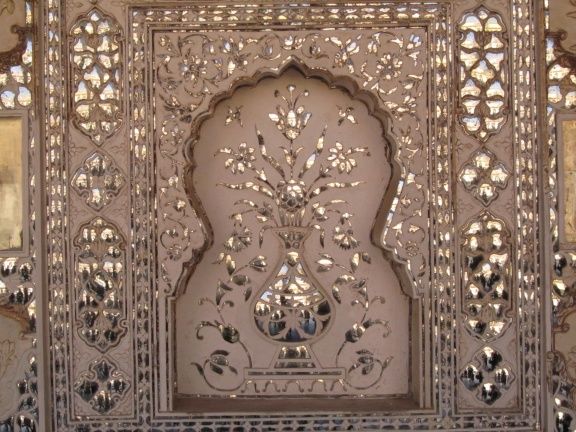FWP:
SETS
== SYMMETRY
GAZE: {10,12}
JAUHAR: {5,4}
MADNESS: {14,3}
MIRROR: {8,3}
For background see S. R. Faruqi's choices. This verse is NOT one of his choices; I thought it was interesting and have added it myself. For more on Ghalib's unpublished verses, see the discussion in {4,8x}.
The divan version of the ghazal has no opening-verse; but when the ghazal was originally composed, according to Raza's sequencing {16,6x} was its opening-verse, and the present verse followed it as a second opening-verse.
Well, in this verse it seems that somebody or something has been hunting somebody or something else. One of these entities is junūn-e dīd , either the madness 'of' sight (viewing something so intensely beautiful (?) drives the viewer crazy) or the madness 'for' sight (intense desire for a sight of something drives the desirer crazy). This 'madness of sight' was either 'longing-hunting' (it was pursuing its prey, a 'longing'), or 'longing-hunted' ('longing' was pursuing it, to overpower it and make prey of it); the grammar of the compound tamannā-shikār can go either way. Whose 'madness of sight' is this, asks the first line. Needless to say, we haven't a clue; we can only turn to the second line in the hope of some clarification.
As so often, the grammar and imagery start completely afresh. And there's obviously what I call 'symmetry' operating: we can read either 'A was B' (2a), or 'B was A' (2b). In this particular verse, because of the ambiguity of 'polishmarks-dust', these are actually quite different choices. The first alternative (2a) locates the setting in a mirror-chamber, and then likens the polish-marks on the mirrors to the dust kicked up in a narrow valley by a vigorous hunter and a desperate prey. The second alternative (2b) locates the setting in a narrow valley full of dust churned up by a vigorous hunter and a desperate prey, and then likens this dust to the polish-marks on mirrors in a mirror-chamber.
In either case, there's a down-to-earth problem in the imagery that apparently doesn't even register in the stylized world of the ghazal. For a 'mirror-chamber' is inset with small mirror fragments made of glass; various examples survive in early-modern Mughal and Rajasthani palaces. For more on mirror-chambers, see {10,5}. Naturally such bits of glass have no 'polish-marks', for these are created only by the scouring and polishing of a metal mirror, to keep the verdigris off it. For more on glass versus metal mirrors, see {16,2}.
Apparently we first notice the scene depicted in the second line: either a mirror-chamber full of the 'clouds of dust' of polish-marked mirrors, or a narrow valley full of clouds of dust that suggests a mirror-chamber full of polish-marked mirrors. In either case, we conclude that a hunt has been in progress, and we wonder about the identity of the chief personage involved, the one who harbors the 'madness of sight'. Can we narrow the chase scene down any more than that? I don't think so, really. It's a profoundly interrogative, inshāʾiyah verse: asking the question is really its chief intention.
After all, exactly this technique goes all the way back to {1,1}; the present verse is only a bit more obscure than that first one. That bit of greater obscurity is a crucial one, however, and makes for an overly indeterminate verse. The previous verse, {16,6x}, has a similar structure but manages to be somewhat less open-ended.
Note for grammar fans: The noun compounds tamannā-shikār and jauhar-ġhubār are 'reversed iẓāfat ' constructions; for more on these, see {129,6x}. And āʾīnah-ḳhānah could be considered one too, except that it has become a sort of petrified phrase in its own right.

Asi:
After all, whose madness of/for sight was this, that was hunting down longing? Because of which the mirror-chamber seemed to be a kind of valley in which the dust of polish-marks was flying around.
== Asi, p. 63